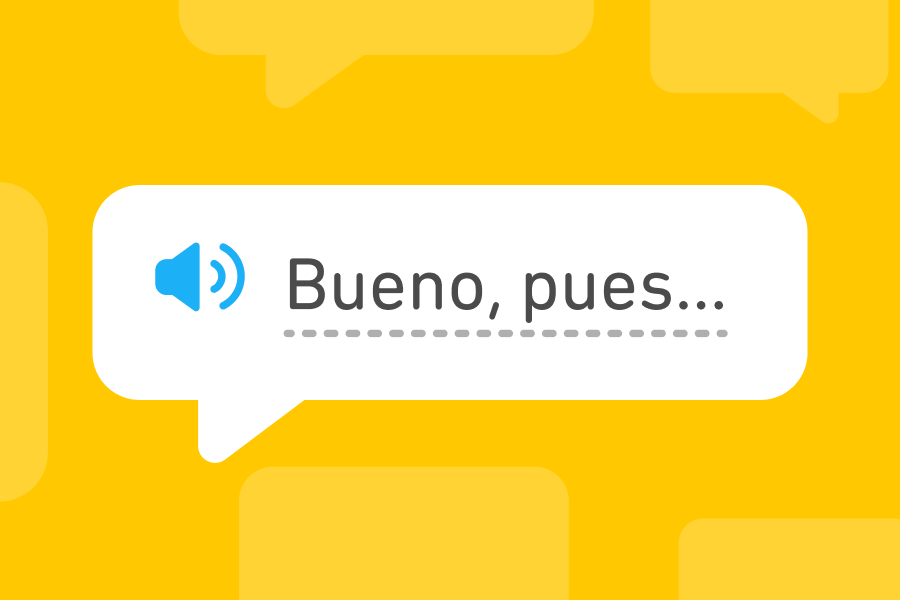We all need a bit of help sometimes—learners included! When it comes to language, speakers use lots of strategies to connect ideas, let your listener know how you feel about what you’re saying, and buy you time. In Spanish, these are called muletillas, or “crutches”!
Here are some ways you can prop up your Spanish for more natural conversations.
Spanish filler words
One muletilla is the filler word: a short word or expression that speakers use to connect sentences or ideas or buy time to formulate their next idea.
Here are some fillers you’ll hear in Spanish:
| Filler phrase | Meaning | Example | Translation |
|---|---|---|---|
| o sea | it’d be / I mean / or rather | No tengo ninguna idea cuando vienen, o sea, no he hablado con ellos. | I don’t have any idea when they are coming, I mean, I haven’t talked to them. |
| digamos | let’s say | Tenemos 3 litros, digamos, más o menos. | We have 3 liters, let’s say, more or less. |
| así que | so | Soy perfeccionista así que necesito más tiempo para arreglarme. | I’m a perfectionist so I need more time to get ready. |
| a ver | let’s see | A ver, ¿dónde está el celular? | Let’s see, where’s my phone? |
| bueno | good | Mmm, bueno, ¿subamos? | Mmm, good, should we get on? |
| pues | well | ¿Van al club? Pues, ¡me encanta bailar! | Are you all going to the club? Well, I love to dance! |
| bueno, pues | good, well | Bueno, pues, ¿cuándo llegaste? | Good, well, when did you arrive? |
As you can see, bueno and pues can be used on their own or together in a single phrase. Alone, they can be short responses to indicate that you agree with the person who’s talking. And to give yourself even more time to think or to prepare for your turn to talk, you can say Bueno, pues, mira before making your point.
Spanish conversational expressions
Other Spanish expressions keep you, as the listener, in the conversation and help you show agreement. For example, sí (yes), bien (well), vale (okay, used in Spain), dale (okay, used in Latin America), de acuerdo (agreed), verdad (true), va (literally, “it goes”), súper (super, great), and ya (roughly translated as “yes”) are all positive signals to your conversation partner that you are paying attention and understand their point.
The imperative forms venga (Come on!), vamos (Let’s go!), vaya (Go on!) and anda (Walk/Come on!) are also commonly used as filler responses. They can indicate admiration, surprise, disbelief, or even irony, depending on the speaker’s tone. They emphasize what the other person has said. For example:
A: ¡Acabo de ver a Tom Cruise en el café! (I just saw Tom Cruise in the café!)
B: ¡Vaya! No puede ser. Está en California. (Come on! That can’t be. He’s in California.)
To really add emphasis with anda, you can repeat it—Anda, anda—or say definitively Ándale pues. And if you are in complete disbelief of what you just heard, try ¡Anda que no!
Spanish tag questions
Tag questions are another way to make your speech more natural, especially to keep your listener focused or to check that they understood.
| Tag question | Meaning | Example | Translation |
|---|---|---|---|
| ¿Cierto? | Right? | No tienes la hora, ¿cierto? | You don’t know the time, right? |
| ¿Sabes? | You know? | La cena es un poco exagerada, ¿sabes? | The dinner is a bit excessive, you know? |
| ¿Ves? | See? | El mensaje es complicado, ¿ves? | The message is complicated, see? |
| ¿(Me) entiendes? | Do you understand (me)? | La reunión es mañana, y no estoy lista, ¿entiendes? | The meeting is tomorrow, and I’m not ready, understand? |
These questions can be used with literal meaning or more figuratively—for example, it’s possible that your listener actually can’t hear you or literally does not understand you! Most likely, though, you’ll use these expressions—and hear them from Spanish speakers—to check that the listener is on board or agrees with what you’re saying, ¿sabes?
Use language crutches to help you along
Spanish muletillas may feel like crutches to learners, but they are a natural part of using any language!
